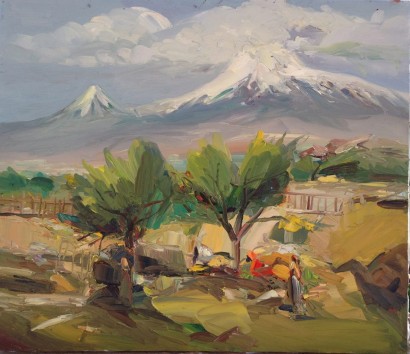
Ararat Leran Masin Texekutyun
Oct 12, 2013 - Erevan@ Q.a. 782 tvakanin Araratyan dashtavayrum himnadrel e Argishti Aradzhin. Hin Erevani masin patkeratsum enq kazmum voch miayn hay. Araratyan dashtum ev bibliakan Ararat leran@ mot gtnvelu past@ himq en.
 Contents • • • • • • • • • • • • • • • • • • • • • • • • • • • • • • • • • • • • • • • • • • • Political borders Mount Ararat forms a near- between,,. Its summit is located some 16 km (10 mi) west of both the border and the border of the exclave of Azerbaijan, and 32 km (20 mi) south of the Armenian border. The Turkish–Armenian–Azerbaijani and Turkish–Iranian–Azerbaijani are some 8 km apart, separated by a narrow strip of Turkish territory containing the road which enters Nakhchivan at. From the 16th century until 1828 the range was part of the Ottoman-Persian border; Great Ararat's summit and the northern slopes, along with the eastern slopes of Little Ararat were controlled by Persia. Following the and the, the Persian controlled territory was ceded to the Russian Empire.
Contents • • • • • • • • • • • • • • • • • • • • • • • • • • • • • • • • • • • • • • • • • • • Political borders Mount Ararat forms a near- between,,. Its summit is located some 16 km (10 mi) west of both the border and the border of the exclave of Azerbaijan, and 32 km (20 mi) south of the Armenian border. The Turkish–Armenian–Azerbaijani and Turkish–Iranian–Azerbaijani are some 8 km apart, separated by a narrow strip of Turkish territory containing the road which enters Nakhchivan at. From the 16th century until 1828 the range was part of the Ottoman-Persian border; Great Ararat's summit and the northern slopes, along with the eastern slopes of Little Ararat were controlled by Persia. Following the and the, the Persian controlled territory was ceded to the Russian Empire.
Left Behind (2000) This is a great depiction of the rapture as found in the book of Revelation.  It stars very well-known Kirk Cameron (also in Fireproof) as he plays the role of Buck Williams who has been left behind after the rapture.
It stars very well-known Kirk Cameron (also in Fireproof) as he plays the role of Buck Williams who has been left behind after the rapture.
Little Ararat became the point where the Turkish, Persian, and Russian imperial frontiers converged. The current international boundaries were formed throughout the 20th century. The mountain came under Turkish control during the 1920. It formally became part of Turkey according to the 1921.
In the late 1920s, Turkey crossed the Iranian border and occupied the eastern flank of Lesser Ararat as part of its effort to quash the, during which the Kurdish rebels used the area as a safe haven against the Turkish state. Iran eventually agreed to cede the area to Turkey in a.
The Iran-Turkey boundary skirts east of Lesser Ararat, the lower peak of the Ararat massif. As of 2004 the mountain is open to climbers only with 'military permission'. The procedure to obtain the permission involves submitting a formal request to a Turkish embassy for a special 'Ararat visa', and it is mandatory to hire an official guide from the Turkish Federation for Alpinism. Access is still limited, even for climbers who obtain the necessary permission, and those who venture off the approved path may be fired upon without warning. Names and etymology. Mount Ararat 3D Summit ice cap The on the summit of Mount Ararat has been shrinking since at least 1957.
In the late 1950s, Blumenthal observed that there existed 11 outlet emerging from a summit snow mass that covered about 10 km 2 (3.9 sq mi). At that time, it was found that the present glaciers on the summit of Ararat extend as low as an elevation of 3,900 meters (12,800 ft) on the north-facing slope, and an elevation of 4,200 meters (13,800 ft) on its south-facing slope. Using pre-existing and data, Sarıkaya and others studied the extent of the ice cap on Mount Ararat between 1976 and 2011. They discovered that this ice cap had shrunk to 8.0 km 2 (3.1 sq mi) by 1976 and to 5.7 km 2 (2.2 sq mi) by 2011. They calculated that between 1976 and 2011, the ice cap on top of Mount Ararat had lost 29% of its total area at an average rate of ice loss of 0.07 km 2 (0.027 sq mi) per year over 35 years.